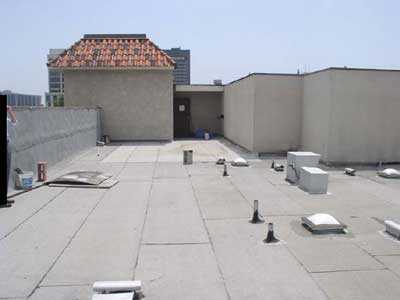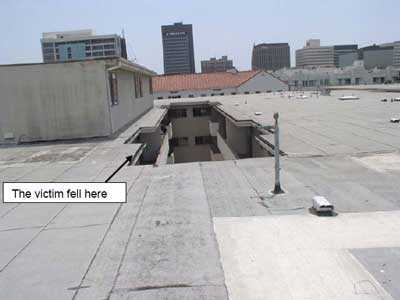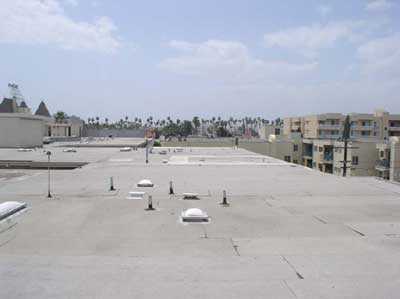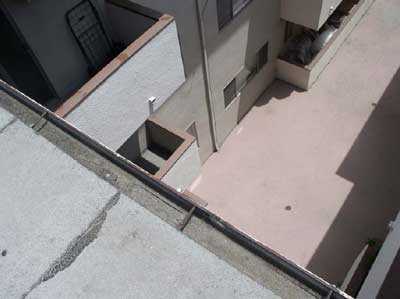A Maintenance Worker Dies When He Falls Off the Roof of an Apartment Building.
California Case Report: 08CA001
Summary
A 42-year-old Hispanic maintenance worker died when he fell from the flat roof of a three-story apartment building. The victim was working by himself repairing a leak in the roof at the time of the incident. There were no warning lines or perimeter barriers on the roof and the victim was not using any personal fall protection equipment. The employer of the victim did not have any safety or training programs available for their employees. The CA/FACE investigator determined that, in order to prevent future occurrences, employers should:
- Ensure fall protection is used by workers performing roof repairs.
- Develop and implement a safety and training program for employees to follow.
In addition:
- Building owners should consider the installation of guardrails around the perimeter of flat roofs wherever feasible.
Introduction
On December 26, 2007, at approximately 3:00 p.m., a 42-year-old Hispanic maintenance worker died when he fell from the roof of a three-story (40 feet high) apartment building. The victim was working by himself performing roof repair at the time of the incident. The CA/FACE investigator was notified of this incident on December 27, 2007, by the Los Angeles District Office of the Division of Occupational Safety and Health (Cal/OSHA). Contact with the employer was made on January 9, 2008. On January 22, 2008, the CA/FACE investigator traveled to the worksite of the victim and interviewed the company regional manager and the manager of the building. The CA/FACE investigator viewed the roof and took pictures of the area where the victim fell.
The employer of the victim was a property management company that managed various properties and apartment complexes throughout Los Angeles. They had been in business for 25 years and had approximately 65 employees. The victim had been employed with the company for 14 months. The victim was born in El Salvador and had been in the United States for seven years. According to his employer, he spoke and read English well. The victim had completed some years of college education.
The employer of the victim did not have a safety program or a written Injury and Illness Prevention Program (IIPP). Safety meetings were not held or documented. The company did not have a formal training program. Employees were hired based on their work experience, and specific job task proficiency was assessed through observation by the immediate supervisor.
Investigation
The site of the incident was the flat roof of a three-story apartment building (see Exhibits 1 through 5). The roof was rectangular in shape with a central opening for the building's patio below. There were no guardrails or warning lines on the roof perimeter or the perimeter of the central opening. The area of the roof that was leaking was in the northeast portion of the roof. The leaking roof area was surrounded by a five-foot high parapet wall on the north and the exterior walls of a penthouse on the east and south.
On the day of the incident, the victim was assigned to repair the leaking portion of the building roof. The leaking roof area was approximately 35 feet from any unprotected roof edge. The victim accessed the roof through an interior stairwell. Two routes could be taken from the stairwell to the repair area. Neither route passed near an unprotected edge. The tenants in one of the third floor apartments heard the victim walking on the roof, and then heard a thumping sound. The tenants saw the victim lying on the ground floor cement patio below and notified the building manager. The building manager notified emergency personnel who pronounced the victim dead at the scene.
It is not known what task the victim was performing at the time he fell. The incident scene suggests that he fell from the edge of the building as he was walking around the penthouse to reach the roof area that needed repair. No fall protection equipment was provided to the victim.
Cause of Death
The cause of death, according to the death certificate was multiple blunt injuries.
Recommendations/Discussion
Recommendation #1: Ensure fall protection is used for workers performing roof repairs.
Discussion: In this incident, the victim was working on three-story roof with no fall protection. His work did not require him to approach an unprotected roof edge, and it is not known what task he was performing when he fell. Fall protection systems protect workers in transit to their work area, while they are actively engaged in work tasks, and while not performing work-related tasks but still in the work area. These fall protection systems can prevent falls or mitigate injuries if a fall does occur. There are multiple methods for providing fall protection, e.g., guardrails, safety nets, or personal fall protection systems. Warning lines are also an option if the roof is flat, monolithic (i.e., built-up asphalt, flat seam metal, etc.), and the workers do not need to approach unprotected edges. Tie-backs (anchor points that fall protection is attached to) are required if the height of the roof exceeds 36 feet. As part of an overall fall protection plan, the type of fall protection used at a worksite should be chosen by a person qualified in fall protection design.
Recommendation #2: Develop and implement a safety and training program for employees to follow.
Discussion: In this incident, the employer had no safety or training program in place for the employees to follow. Having a documented safety and training program and an IIPP has proven to be an effective method of ensuring all employees receive the necessary safety information needed to perform their jobs in the safest possible manner. An effective IIPP should contain the following:
- The name of a person or persons with authority and responsibility for implementing the IIPP.
- A system for ensuring that employees comply with safe and healthy work practices.
- A system for communicating with employees in a form readily understandable by all affected employees on matters relating to occupational safety and health, including provisions designed to encourage employees to inform the employer of hazards at the worksite without fear of reprisal.
- Procedures for identifying and evaluating workplace hazards including scheduled periodic inspections to identify unsafe conditions and work practices. Had a hazard walkthrough been performed prior to this incident, the risk of falling would have been identified and control measures could have been taken.
- Procedures to investigate occupational injury or occupational illness.
- Methods and/or procedures for correcting unsafe or unhealthy conditions, work practices, and work procedures in a timely manner based on the severity of the hazard.
- Training and instruction for all new employees and all employees given new job assignments for which training has not previously been received, whenever new substances, processes, procedures, or equipment are introduced to the workplace and represent a new hazard, and whenever the employer is made aware of a new or previously unrecognized hazard. If the victim in this incident had received fall protection training, he could have used established safe work practices to protect himself.
Had the employer had a safety program in place, the hazard might have been identified and eliminated by ensuring that employees who go up on the roof could recognize, evaluate, and control fall hazards.
Recommendation #3: Building owners should consider the installation of permanent guardrails around the unprotected edges of flat roofs wherever feasible.
Discussion: Flat-roofed buildings are different from angled-roof buildings because heating, ventilation, and air conditioning (HVAC) systems and other types of equipment are more likely to be placed on the roof of flat-top buildings. This means that a flat-top roof is commonly accessed by workers to maintain and repair roof-top equipment as well as to maintain and repair the roofing surface. Since many of these workers are employed by companies other than the building's owner, the building owner does not control the level or uniformity of fall protection training and skills these workers possess. A way to insure the safety of all these workers over the entire rooftop, even to the edge of the building, is to install a guardrail around all unprotected edges. In this case that would include guardrails around the entire building's perimeter and the central roof opening for the building's patio.
Reference
- California Code of Regulations, Vol. 9, Title 8, Article 24. Fall Protection, Sections §1669. General, §1670. Personal Fall Arrest Systems, Personal Fall Restraint Systems and Positioning Devices.
- Subchapter 4. Construction Safety Orders, Article 30. Roofing Operations and Equipment
- §1730. Roof Hazards.
- NIOSH Publication No. 2004-156: Preventing Falls of Workers through Skylights and Roof and Floor Openings
- Massachusetts FACE Report https://www.cdc.gov/niosh/face/stateface/ma/97ma044.html
- EHS Today, Managing Roof Hazards in General Industry http://ehstoday.com/news/ehs_imp_33665 (Link updated 3/27/2013)
Exhibits
 |
|
Exhibit 1. The roof where the incident took place. |
 |
|
Exhibit 2. A picture of the north/east corner of the roof where the victim was repairing a leak. |
 |
|
Exhibit 3. The roof opening where the victim fell. |
 |
|
Exhibit 4. A picture of the roof looking south. |
 |
|
Exhibit 5. The spot on the roof where the victim fell. |
 |
|
Exhibit 6. A picture of the patio area where the victim landed after his fall.
|
California Fatality Assessment and Control Evaluation (FACE) Project
The California Department of Public Health, in cooperation with the Public Health Institute and the National Institute for Occupational Safety and Health (NIOSH), conducts investigations of work-related fatalities. The goal of the CA/FACE program is to prevent fatal work injuries. CA/FACE aims to achieve this goal by studying the work environment, the worker, the task the worker was performing, the tools the worker was using, the energy exchange resulting in fatal injury, and the role of management in controlling how these factors interact. NIOSH-funded, State-based FACE programs include: California, Iowa, Kentucky, Massachusetts, Michigan, New Jersey, New York, Oregon, and Washington.
To contact California State FACE program personnel regarding State-based FACE reports, please use information listed on the Contact Sheet on the NIOSH FACE web site. Please contact In-house FACE program personnel regarding In-house FACE reports and to gain assistance when State-FACE program personnel cannot be reached.
California Case Reports- Page last reviewed: November 18, 2015
- Page last updated: October 15, 2014
- Content source:
- National Institute for Occupational Safety and Health Division of Safety Research


 ShareCompartir
ShareCompartir